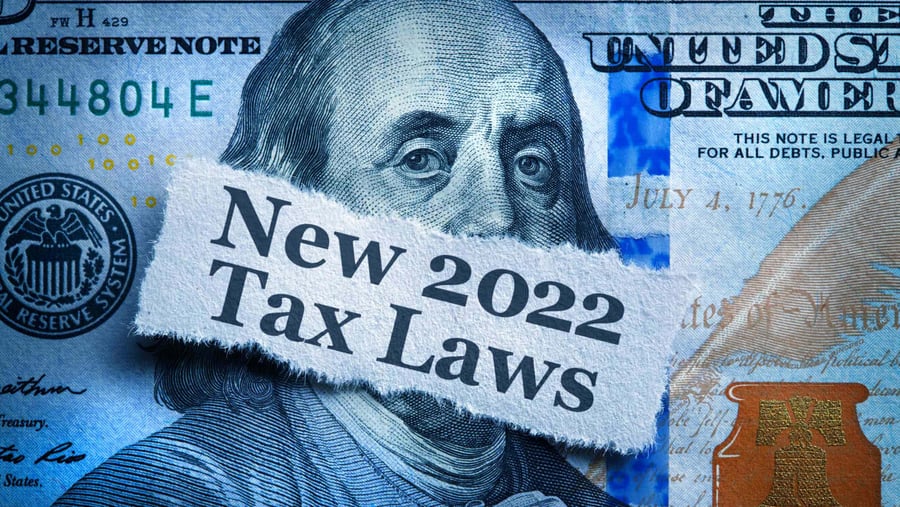Powell Tax Law Blog

Major Tax Changes for 2022
When we think of important tax dates, April 15 always comes to mind – after all, the traditional IRS tax deadline day is usually the culmination of blood, sweat, tears and a few broken No. 2 pencils.
As far as major tax changes, however, the rules and regulations can be rewritten and tweaked on any page of the calendar with some of the major changes for 2022 just announced – and effective! -- by the IRS on July 8, 2022.
“The wealthy now have more time to avoid estate taxes, thanks to an IRS change,” is the spin CNBC put on the IRS change to its “portability” rules.
As for the rest of the tax return you will file next year, expect plenty of number changes.
“The old saying that nothing is certain except death and taxes is only partly true. Yes, you can certainly expect to pay taxes in 2022, but you may not see the same kind of tax return thanks to a number of tax law changes,” reported Wall Street veteran John Csiszar
Tax Changes Affect High Net Worth Married Couples
The “portability” changes – portability allows a surviving spouse to use their partner’s unused exemption along with their own – were announced in an 11-page letter from the IRS.
CNBC explained that portability works like this:
- While a spouse may inherit all their partner’s assets tax-free, estate taxes may be owed after the surviving spouse passes, depending on total value.
- In 2022, the per person exemption for gifts and estate taxes is $12.06 million (up from $11.7 million) – meaning no federal taxes are owed for giving away up to that amount to children or other non-spouse beneficiaries while living or at their death.
- If the surviving spouse elects portability, however, it allows them to use their partner’s unused exemption along with their own, meaning a couple could gift up to $24.1 million before estate taxes come into play.
Some of the big changes that are effective July 8, 2022:
- Spouses now have up to five years after their partner’s death to elect portability, an increase from two years.
- Spouses, electing portability within the 5-year window, no longer need to request guidance from the IRS (called a private letter ruling) but can simply file an estate tax return.
“That’s incredibly simple, so it makes it almost a no-brainer,” CFP Michael Whitty told CNBC.
Annual Inflation Adjustments Change 60+ Tax Provisions
The IRS announced some 60+ tax provisions have been adjusted for annual inflation.
Highlights of these changes for the tax year 2022 (which generally applies to tax returns field in 2023) include:
- Standard Deduction:
o Married couples filing jointly for tax year 2022 rises to $25,900, up $800 from the prior year.
o Single taxpayers and married individuals filing separately, rises to $12,950 for 2022, up $400.
o Heads of households, the standard deduction rises to $19,400 for 2022, up $600.
- Marginal Rates: For tax year 2022, the top tax rate remains 37 percent for individual single taxpayers with incomes greater than $539,900 ($647,850 for married couples filing jointly). The other rates are:
o 35 percent, for incomes over $215,950 ($431,900 for married couples filing jointly)
o 32 percent for incomes over $170,050 ($340,100 for married couples filing jointly)
o 24 percent for incomes over $89,075 ($178,150 for married couples filing jointly)
o 22 percent for incomes over $41,775 ($83,550 for married couples filing jointly)
o 12 percent for incomes over $10,275 ($20,550 for married couples filing jointly)
o The lowest rate is 10 percent for incomes of single individuals with incomes of $10,275 or less ($20,550 for married couples filing jointly)
- Personal Exemptions: The personal exemption for tax year 2022 remains at 0, as it was for 2021, this elimination of the personal exemption was a provision in the Tax Cuts and Jobs Act.
- Itemized Deductions: For 2022, as in 2021, 2020, 2019 and 2018, there is no limitation on itemized deductions, as that limitation was eliminated by the Tax Cuts and Jobs Act.
- Alternative Minimum Tax: AMT exemption amount for tax year 2022 is $75,900 and begins to phase out at $539,900 ($118,100 for married couples filing jointly for whom the exemption begins to phase out at $1,079,800). The 2021 exemption amount was $73,600 and began to phase out at $523,600 ($114,600 for married couples filing jointly for whom the exemption began to phase out at $1,047,200).
- Earned Income Tax Credit: Tax year 2022 maximum Earned Income Tax Credit amount is $6,935 for qualifying taxpayers who have three or more qualifying children, up from $6,728 for tax year 2021.
- Qualified Transportation Fringe Benefit: For tax year 2022, the monthly limitation for the qualified transportation fringe benefit and the monthly limitation for qualified parking increases to $280.
- Employee Salary Reductions: For the taxable years beginning in 2022, the dollar limitation for employee salary reductions for contributions to health flexible spending arrangements increases to $2,850. For cafeteria plans that permit the carryover of unused amounts, the maximum carryover amount is $570, an increase of $20 from taxable years beginning in 2021.
- Medical Savings Account: For tax year 2022, participants who have self-only coverage in a Medical Savings Account, the plan must have an annual deductible that is not less than $2,450, up $50 from tax year 2021; but not more than $3,700, an increase of $100 from tax year 2021. For self-only coverage, the maximum out-of-pocket expense amount is $4,950, up $150 from 2021. For tax year 2022, for family coverage, the annual deductible is not less than $4,950, up from $4,800 in 2021; however, the deductible cannot be more than $7,400, up $250 from the limit for tax year 2021. For family coverage, the out-of-pocket expense limit is $9,050 for tax year 2022, an increase of $300 from tax year 2021.
- Health Savings Account: For tax year 2022, HAS contribution limits rise to $3,650 for self-only coverage (up from $3,600) and $7,300 for families (up from $7,200). Annual “catch-up” contribution for individuals aged 55 or older remains $1,000.
- Lifetime Learning Credit: Modified adjusted gross income amount used by joint filers to determine the reduction in the Lifetime Learning Credit is not adjusted for inflation for taxable years beginning after December 31, 2020. The Lifetime Learning Credit is phased out for taxpayers with modified adjusted gross income more than $80,000 ($160,000 for joint returns).
- Foreign Earned Income Exclusion: For tax year 2022, the foreign earned income exclusion is $112,000 up from $108,700 for tax year 2021.
- Annual Exclusion for Gifts: Increases to $16,000 for calendar year 2022, up from $15,000 for calendar year 2021.
- Maximum Credit Allowed for Adoptions: For tax year 2022 is the amount of qualified adoption expenses up to $14,890, up from $14,440 for 2021.







